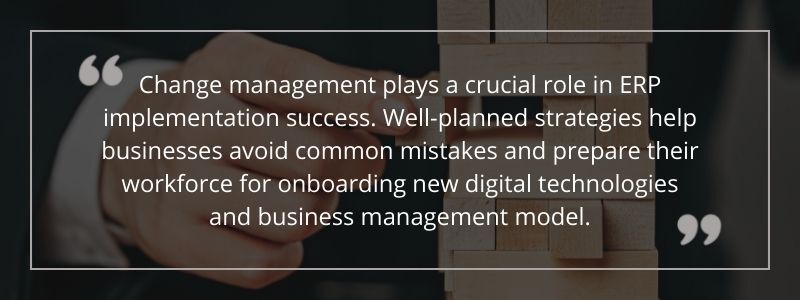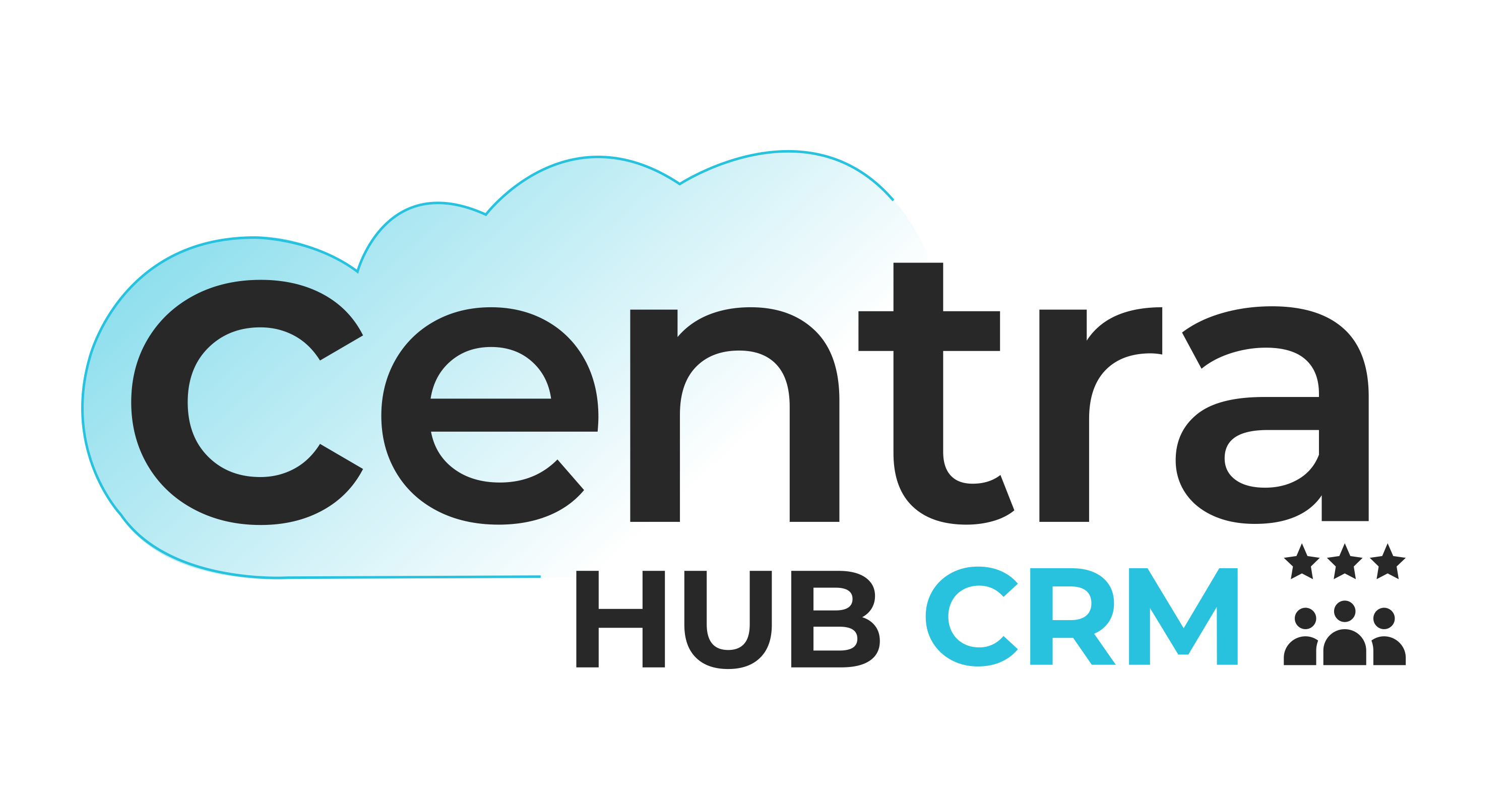What are ERP Implementation Challenges?
ERP implementation is not a stand-alone event. The process involves employees, operations, and funds. Improper ERP project management could lead to common mistakes causing challenges for successful deployment.
- The absence of alignment between program objectives and business outcomes – This leads to investing in systems that are misaligned with organizational needs.
- Underestimating the importance of setting up a strong internal and external communications strategy - This makes the key individuals or organizations unprepared for the change.
- The ERP initiatives only focus on technical functionalities at the cost of business processes and organizational structure changes – these results inexpected benefits from the program getting compromised or delayed.
- Lack of training opportunities on the new system – This makes the staff confused and processes dysfunctional, putting the business operations at risk.
Checklist for Successful ERP Transformation
Preparing for success is the first step towards a successful ERP implementation. It needs careful planning and understanding to readily embrace the transformation. Your ERP project team need to:
- Ensure that finance functions are well represented by driving the accountability of program benefits.
- Implement metrics and controls so that the ERP deployment project stays on track and delivers the agreed business outcomes even with external and internal environment changes.
- Dedicate resources early to define standard processes and keep track of business readiness to adopt the new system.
- Arrange for training by function and appoint users from the business as change agents.
- Design a cross-functional communication strategy to ensure both employees and external partners (customers, suppliers, and shareholders) are aware of and prepared for the change.
What are the Key Elements of Organizational Change Management Strategies?
ERP implementation is inevitable, and its success impacts the business processes. To make this transition as smooth as possible, you need to plan and implement a compelling practical change management strategy across five imperatives:
- Driving enterprise wide business engagement
- Measuring organization readiness to adopt change
- Tracking and measuring change through defined metrics
- Enforcing training readiness and rigor
- Implying communication strategy
Driving enterprise wide business engagement
Cross-functional business engagement and consensus on software priorities are essential foundations for ERP deployment success. Organizations need to ensure their ERP implementation program has engagement at all levels and across all the functions of the organization. This is about tasking your ERP project team to identify key users - the individuals who would do system walkthroughs and test the new software. The fact here is that successful application of the change brought through ERP transformation is the responsibility of every individual involved with the organization.
Measuring organization readiness to adopt change
ERP software has a significant impact in redefining current processes and restructuring your organization in a way that helps you drive benefits. For this, you need to assess your existing organizational structure and device structural change, if required, to take advantage of the newly defined processes and systems.
Activities that were previously performed independently by different departments could now be centralized. Information collected could be effortlessly accessed and shared, manual processes could be eliminated with the advent of automation and outsourcing. Process standardizing brought by ERP software provides the organization with the benefits of efficient resource utilization, improved analytics, and automation opportunities.
Whether enforcing training or driving new system enhancements, as soon as the change in processes is identified, you need to perform a functional assessment to map out a plan by timeline and business unit on when the proposed organizational changes could be executed.
This is a continuous approach, and you need to measure your organizational readiness for every upcoming change during the program phase and take appropriate action to ensure that your business absorbs the change brought by the new technology.

Tracking and measuring change through defined metrics
In the evolving business environments, when your standalone systems are unable to keep up with your organizational objectives, you need to plan to adapt an ERP program. An effective way to do that is by identifying the critical business KPIs that would be improved through the ERP transformation. Design a model to capture all the benefits like improved data insights, better control over the business processes, and so on.
You could keep track of progress and measure success in four different categories:
Business simplification
When an ERP system is implemented appropriately, it simplifies how your business operates. So, it would be best if you recognize the drivers for simplifying your critical business function aligned with the pain points.
Business process cycle time
Process standardization is one of the most significant benefits of an ERP program.
While implementing the system, if your ERP team spends a disproportionate amount of time on one aspect, other functionalities might suffer. Task your team to identify, define, and modulate entitlement of cycle time to avoid the imbalance.
Employee productivity
An advanced ERP solution enables you to digitize end-to-end processes.
It is embedded with AI technology to automate and speed up your day-to-day business operations that were previously carried out by the employees manually. This reduces your employees’ involvement in repetitive tasks, and they could utilize their time in performing what is more important for business growth and increase their productivity.
Operational efficiencies
An ERP solution impacts and benefits all business functions. It helps you digitally collaborate with different departments, resulting in faster and improved quality of productions or services. Build a standard process in the ERP system to improve customer service and organizational performance.
Enforcing training readiness and rigor
A well-defined training program is critical for your team to understand the ERP deployment process and use the software post-implementation. You need to task your ERP team to start drafting training plans early to ensure all individuals or functions are included in the digital transformation initiative.
The training has to be focused on both system functionality and the individuals using it. So, it needs to include new processes and roles to prepare people for the change. Though training demands majorly tend to spike once the ERP system is actively being used, ensure your program team continues to build and measure the training plan regularly, much after going live. These sessions are interactive and on-demand in nature and readily accessible for the users when they need them.
Implying communication strategy
Internal Communication
Take up the responsibility in communicating the message of change in your organization, especially its impacts and benefits. Also, ensure that your message is consistent across all departments and teams.
Having a planned approach toward communicating information is the key here. Outline the impact of an ERP on each function individually and the overall business. The better your employees are equipped with information, the sooner they would be ready to embrace the new technology and change environment.
External communication
The need for external communication with customers, suppliers, and even shareholders is often overlooked. However, they need to be informed about new processes to continue smooth transactions.
Ensure that your ERP team carefully articulates a detailed communication plan for identifying the customers and suppliers, messages you want to communicate, timing, and potential impact before sharing.
Customers and suppliers look for clarity in terms of the benefits of a new process or system on the business operations and productivity; therefore, you need to be consistent in messaging, tracking, and reporting your business KPIs.
Building Organizational Change Strategies an Expert Approach to ERP Deployment
In the age of cut-throat competition, it has become even more important for a company to ensure its investment is put to the correct use.
If you contemplate an ERP implementation, an effective change management strategy could make your transition effortless. But it takes a lot of effort to create a change management plan, and that is where we come in. We offer the best ERP software in Middle East and have the resources required to help you manage hassle-free ERP deployment.
Fill in the form to request a free consultation.







